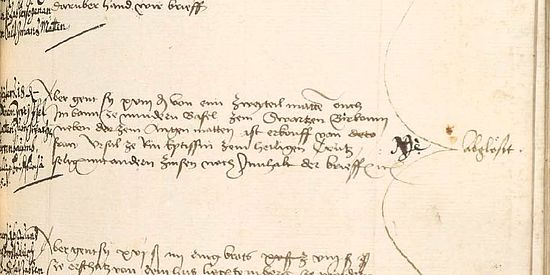Aline Hélène Vonwiller

Zur Geistlichkeit im ZinsgeflechtEine sakralökonomische Topographie des spätmittelalterlichen Häusermarktes in Basel (1400-1530)
Die jüngere Forschung zur mittelalterlichen Wirtschaftsgeschichte erzielt durch die Anwendung einer veränderten Begrifflichkeit für ihre analytischen Kategorien neue Resultate (Dendorfer/Patzold 2023). So sprechen wir im Immobilienbereich etwa nicht mehr von Vasallen oder Lehen – selbst, wenn diese Terminologien Quellennähe aufweisen –, sondern leiten unsere analytischen Begriffe stattdessen primär von der Leihwirtschaft ab. Eine solche veränderte Begrifflichkeit erlaubt es, neue Dynamiken sichtbar zu machen und differenziertere Perspektiven auf die mittelalterliche Immobilienwirtschaft und ihre Akteur:innen zu gewinnen.
Mit digitalen Methoden lassen sich diese Forschungsperspektiven nicht nur unterstützen; sie ermöglichen es auch, herkömmliche und stark verankerte Vorstellungen zur Wirtschaftsstruktur durch quantitative Analysen und deren räumliche Verteilung zu hinterfragen, in dem sie neue Strukturen sichtbar zu machen.
Unter diesen Prämissen konzentriert sich das Projekt auf die geistlich-organisatorische Gesellschaftsebene und damit auf institutionelle Akteur:innen im Spätmittelalter (1400-1530). Es untersucht, auf welche Weise verschiedene geistliche Institutionen (Klöster, Stifte, Spitäler) in die Immobilienwirtschaft eingebunden waren und, wie sie mit anderen Gesellschaftsebenen verflochten waren. Zusätzlich zu den rein quantitativen Auswertungen und deren Entwicklung über das 15. Jahrhundert ermöglichen Analysen zur räumlichen Verteilung im städtischen Raum neue Erkenntnisse über die wirtschaftlich-sozialen Verhältnisse dieser Institutionen im spätmittelalterlichen Basel.
Viele spezifische Fragen zur mittelalterlichen Zinswirtschaft eröffnen sich: Wie sieht das Ranking der geistlichen Institutionen aus, die Einkommen über die Zinsbeschreibungen erhielten? Für welchen Stift oder welches Kloster spielten welche Zinsen eine grössere Rolle im Kontext ihres institutionsspezifischen, häusermarktorientierten Wirtschaftsprofils? Welche geistliche Institution profitierte in welchen Stadtteilen besonders von bestimmten Zinsen? Welche geistliche Organisation generierte mehr Einkommen durch Kreditvergabe im Zusammenhang mit Rentenkäufen als durch die Verpflichtungen zur Zahlung von Jahrzeiten – und umgekehrt? Oder welche geistliche Institution machte am meisten Gebrauch von der Infrastruktur des städtisch-gerichtlichen Frönungsverfahrens?
Bildnachweis: StABS: Klosterarchiv Klingental, Q Zinsbuch, fol. 124r.
Aktuelle Veranstaltung:
Eigenständige Tagung im Rahmen des IMC Leeds
Datum: 07. Juli 2025
Uhrzeit: 11:15 - 18:30
Titel: Economies of Urban Spaces
Sessions I-III: Historiographies, Actors, Digital Methods
Collecting Interest, Leasing property, and Seizing Houses:
On the Entanglement of Ecclesiastical Institutions in the Late Medieval Property Market in Basel (1400-1530)
German-speaking historiography of medieval economic history is achieving new results by applying a modified terminology to its analytical categories (Dendorfer/Patzold 2023). In the real estate sector, for example, we no longer speak of vassals or fiefs – even if this terminology is close to the sources – but instead derive our analytical terms primarily from the loan economy. Such a change in terminology makes it possible to visualise new dynamics and gain more differentiated perspectives on the medieval real estate economy and its actors.
Digital methods can not only support these research perspectives; they also make it possible to question conventional and deeply rooted ideas about economic structure through quantitative analyses and their spatial distribution, and to make new structures visible.
The project focuses on the spiritual-organisational level of society and thus on institutional actors. It examines how various ecclesiastical institutions (monasteries, convents, hospitals) were integrated into the real estate economy and interacted with different levels of society. In addition to the purely quantitative evaluations and their development over the 15th century, analyses of spatial distribution in urban areas provide new insights into the economic and social conditions of these institutions in late medieval Basel.
Many specific questions about medieval interest management arise: What is the ranking of the ecclesiastical institutions that received income from interest payments? For which foundation or monastery did interest play an important role in the context of their specific economic profile geared to the property market? Which ecclesiastical institution benefited particularly from certain interest rates in which districts? Which ecclesiastical organisation generated more income from loans in connection with annuity purchases than from obligations to pay for anniversaries – and vice versa? Or which church institution made the most use of the infrastructure of the municipal court, in the event of non-payment of interest?
Credits: StABS: Klosterarchiv Klingental, Q Zinsbuch, fol. 124r.
Current Event:
Conference within the IMC Leeds
Date: July 7, 2025
Time: 11:15 AM - 6:30 PM
Title: Economies of Urban Spaces
Sessions I-III: Historiographies, Actors, Digital Methods
